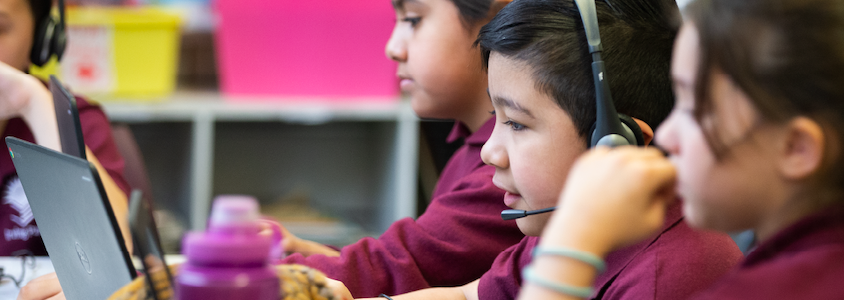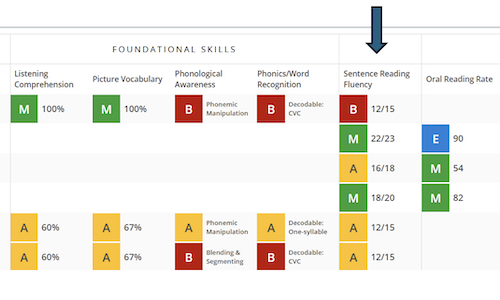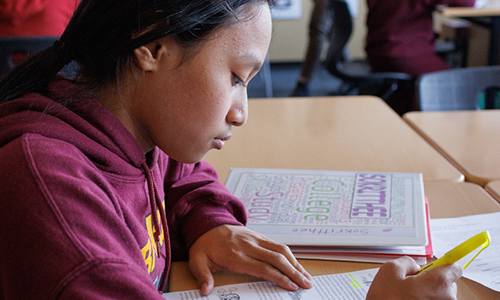 I think a teacher’s most important task at the beginning of the school year is getting to know their students—who they are as people, what they’re interested in, what excites them, and what they are ready to learn. MAP® Growth™ can provide a wealth of data about what each of your students is ready to learn. Before fall testing, it’s helpful to have a conversation with them to help ensure they understand the assessment so they can do their best and so you can get accurate information about each of your students.
I think a teacher’s most important task at the beginning of the school year is getting to know their students—who they are as people, what they’re interested in, what excites them, and what they are ready to learn. MAP® Growth™ can provide a wealth of data about what each of your students is ready to learn. Before fall testing, it’s helpful to have a conversation with them to help ensure they understand the assessment so they can do their best and so you can get accurate information about each of your students.
1. Talk about the purpose
Students—and teachers!—are more likely to focus on and put effort into something if they understand why they’re doing it.
One year, I taught a literature lab class for middle school students. It provided supplemental reading instruction for students needing extra support. One student, an eighth-grader, had taken MAP Growth since third grade. As I looked back on his historical data, I noticed a pattern: every school year since fourth grade, this student had made a huge jump in growth between fall and spring (some years as much as 20 points!). But then his score dropped significantly every summer, so much so that the difference between his reading score in the fall of fourth grade and the fall of eighth grade was only eight RIT points.
I showed my student the data and asked him about it. He explained he’d been intentionally bombing the fall test every year because he’d figured out that when he did much better in the spring, it made the teachers really happy—and got him into the annual pizza party when he was in elementary school.
I explained that those low fall scores were part of the reason he had been in the supplemental reading class every year in middle school. While I believe he still needed the extra support, maybe if his teachers had had a more accurate picture of what he was ready to learn earlier in the year, his class time could have been used more effectively. He could have progressed more quickly through the skills he needed, and he could have ended up with a semester in an elective of his choice, instead of being the only eighth-grader still in my lit lab.
The lesson? Identify how you will use your students’ MAP Growth data (for instructional planning? For differentiation? For goal setting?) and let students know. Help them understand how MAP Growth will support their learning this year.
2. Talk about the questions
When my district first began administering MAP Growth, I was teaching a class of high-achieving fifth-graders. I made it my job to challenge them that year, and for several kids who were used to school feeling easy, being challenged was, in a word, uncomfortable. These students were used to knowing all the answers. Before they took MAP Growth, it was especially important to help them understand that this isn’t the kind of test you can get a 100% on. MAP Growth is designed to measure what each student is ready to learn, so it asks questions to figure out what they know and also what they don’t. The adaptive nature of the assessment means every student will get questions they can answer, and every student will get questions they can’t. The RIT score represents where along the scale a student was answering questions correctly about 50% of the time.
In short, each kid gets a unique test. The questions they receive depend on how they answered previous questions. Encourage students to read each question carefully, and let them know that if a question feels hard, it’s okay to simply make their best guess and move on.
3. Talk about growth and learning
Every student can grow, and every student has room to grow. If possible, have your students review their MAP Growth data from previous school years before they test for the first time in the fall. Talk about what they learned in their classes last year and how what they learned helped them grow. Make connections between the content they’ll learn in your class this year and the areas where they are likely to show growth.
My fifth-graders spent a large chunk of the school year on a research project that involved, among other skills, learning how to determine the validity of a source. I let students know that we would practice this skill throughout the year in a variety of different ways and that the progress they made would likely contribute to growth in their informational reading scores on MAP Growth. More importantly, I told them that growing in these skills would benefit them throughout their lives, in everything from researching and selecting a cell phone plan to reading and watching the news.
4. Talk about what to expect
In our elementary school, students typically took MAP Growth with their class. Students brought a book with them to read after they completed the test, so they would have something to do while they waited for the other students to finish. In our middle school, however, students tested by grade level. Students were pulled out of class one-by-one to test, and they returned to class as soon as they finished so another student could take their turn.
However the logistics of testing work in your building, let students know ahead of time what to expect. When will they be testing? Which subjects? Where will the testing take place? Who will be in the room with them? How long will it take? Remind students that the test is untimed, so they don’t need to rush.
In closing
Obtaining accurate, timely data about your students’ academic strengths and needs early in the school year helps provide a foundation to build on throughout the year. Having open conversations with your students about MAP Growth helps set a foundation for a culture of learning in your classroom and a year full of growth.






